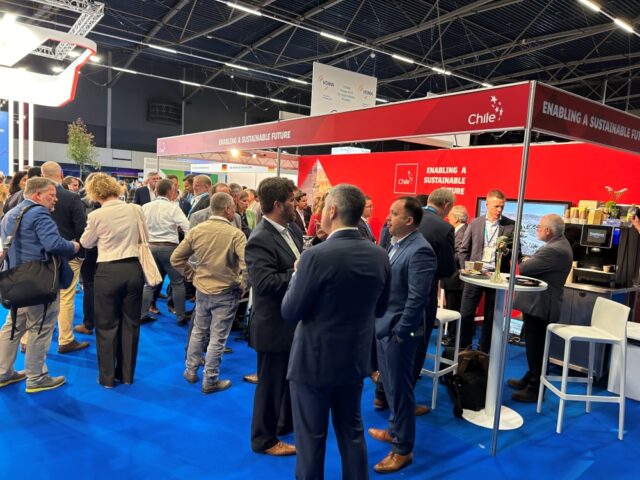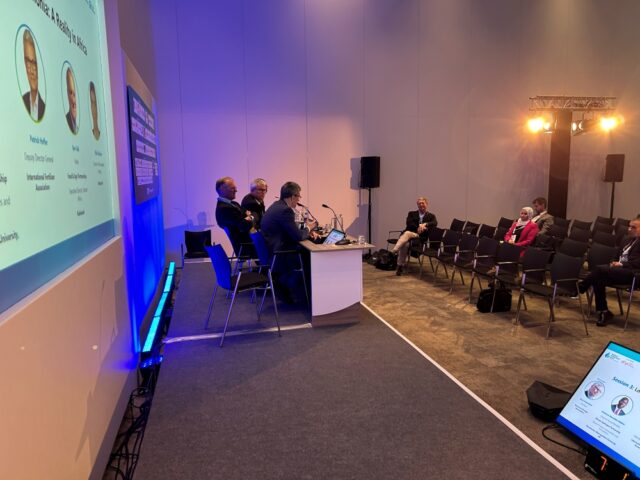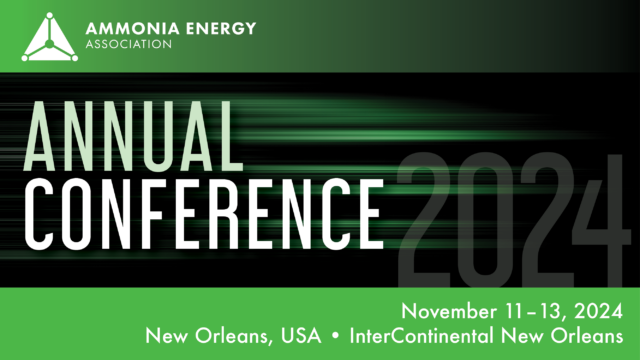Keep pushing: a message from the AEA President
By Hans Vrijenhoef on May 21, 2024

Discussions at the recent World Hydrogen Summit in Rotterdam, Netherlands. Photo by Hans Vrijenhoef.
This year is already moving extremely fast. With all the developments, it’s hard to find the time to write my regular column!
Having participated in various seminars, webinars, conferences and summits since the start of the year, I can say for sure that ammonia discussions are in an exciting phase. No longer is the conversation focused solely on production, but there is so much talk around the key enablers, including safety, public perception, permitting, regulations, storage, and of course off-takers.
Hesitation outside our circles
But, although our community is working hard and making great progress, outside our circles I hear doubts. Even in 2024 I have heard people ask: is ammonia the way to go, or will there be other energy carriers which will develop faster, are cheaper, will be easier implemented, and are less hazardous? Potential stakeholders who want to engage are still worried whether their investments will be too risky, particularly as the market and regulatory landscape for low-emission ammonia is not well-defined.
To this, I have delivered the same message a few times already this year.
New markets are difficult

At the Rotterdam Summit, I hosted a fascinating panel on Africa’s ammonia opportunity, featuring the African Hydrogen Partnership, the International Fertilizer Association, Rabobank and Sonatrach. Photo by Hans Vrijenhoef.
With the introduction of any new product, either as a commodity or a service, or the introduction of a new application for an existing product, like the use of ammonia as a fuel, there are all kinds of risks associated. And risks create delays. This has always been the case for energy commodities, notably the “recent” market entrant LNG. But for ammonia, it has been very clear for years that it is the only energy carrier which can make a big impact on CO2 emissions. No other energy carrier can lead to the scale of international impact required. And therefore we should see these delays as a question of “if” but of “when” the ammonia energy market will take off.
Hidden costs, lowest pollution

AEA President-Elect Vibeke Rasmussen addresses the audience during a panel discussion at the World hydrogen Summit in Rotterdam. Source: World Hydrogen 2024.
Certainly, for the use of hydrogen or ammonia fuel, we must completely mitigate or emit no more pollutants than fossil fuels currently do. Even burning H2 in gas turbines will produce NOX emissions, just as currently happens with fossil fuels. But we can be confident of producing less pollutants with these fuels than with fossil-based ones, using a combination of mature technologies like fuel cells, selective catalytic reduction, and others. We should focus on the lowest overall emission of pollutants to the environment, and the lowest carbon intensity product.
We also hear that it is not always clear if all the “hidden costs” are correctly allocated to any fuels we choose to utilize. But our certification initiative directly addresses these challenges, providing transparent and verifiable data for critical questions like upstream methane leakage and N2O emissions, meaning that even for “blue” production pathways we can be confident that low-emission ammonia emits less overall pollution than fossil fuels (which, by the way, have almost none of their “hidden costs” accounted for!).
So I was amazed to see that, at the recent World Hydrogen Summit in Rotterdam as well as the Arab Fertilizer Association conference in Cairo, there were still a lot of visitors, companies, and governments talking about potentially using methanol or other carbon-based fuels (DME, synthetic methane) as energy carriers long-term. To me, this means that the message above is still not clear in people’s minds.
First-movers will be rewarded
For this reason, I wish to make a statement to all potential players in the ammonia industry. The ammonia market will develop, like the oil and gas market today, with many suppliers and many off-takers. It will not be as concentrated as today’s energy market, which is dominated by a relative handful of producers and off-takers. It will be more open, and prices in the market will fluctuate as much as can be seen in today’s commodities. We won’t be forever stuck waiting for the price of low-emission ammonia to fall. Those who make the early moves to set up the best supply chains will be the long term winners in this transition, and we have many, many examples of these first-mover initiatives in our article archive at the AEA.

The audience listens at the recent NH3 Event LATAM, held in Santiago, Chile. Photo by Hans Vrijenhoef.
To our AEA members: continue to cooperate, to create, to partner, and to innovate. The smallest improvements will have a big effect on the speed for developing our global, low-emission ammonia market.
There is a big role for all of us at these events, whether in Rotterdam, Cairo, Santiago, or elsewhere, to spread these messages about ammonia, but also to make the contacts that will enable the growth of the new markets. The AEA has a wealth of information and knowledge available to those unsure about ammonia, so make sure to point people in our direction.
Don’t avoid the tough conversations
Ammonia was not very much highlighted in Rotterdam (15,000 participants), where hydrogen was the main topic , nor Cairo (800 participants), where fertilizer was the main topic. At both events I saw a tendency to avoid ammonia discussions, either from a cost perspective, or because it was deemed to be too “difficult”. As long as there are voluntary schemes and no clear obligations, the low-emission ammonia market is still seen as a niche, attracting few participants and little attention at these larger events. But we cannot wait until the obligations and imperatives arrive on our doorstep, by which point we will be too late.
The NH3 Event conference in Santiago (160 participants), was of course focused solely on ammonia, as will the upcoming NH3 Event at Rotterdam Zoo (June 6-7). But we do not see too many off-takers or governmental regulators present in our audience there, and I think these individuals are most needed to speed up the development of the ammonia market.
Already looking forward to New Orleans
It is for this reason that I’m already looking forward to the AEA’s annual conference in New Orleans this November. It will be a unique opportunity to further explore the fast-growing business of low-emission ammonia, and provide valuable insight on all the market development aspects. The AEA’s annual events inspire confidence, and provide you with all the material you need to convince regulators, business partners, prospective developers, politicians and friends. Until November I will continue to spread the ammonia message at other global events, but I cannot wait to see you all in-person.
